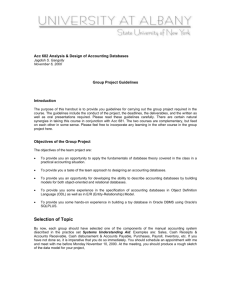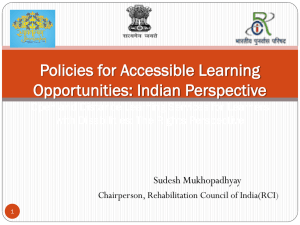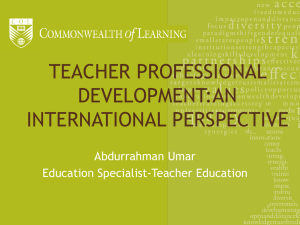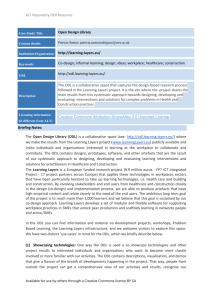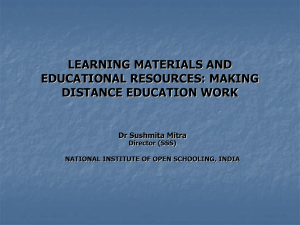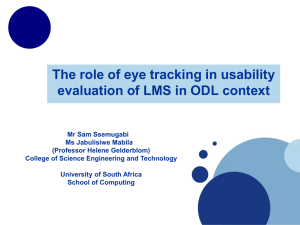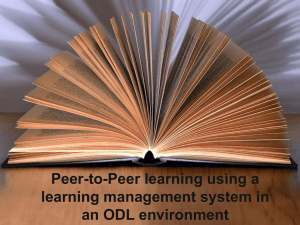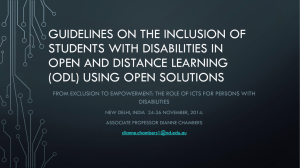Interaction in Open Distance Learning: Research Issues in Malaysia
advertisement
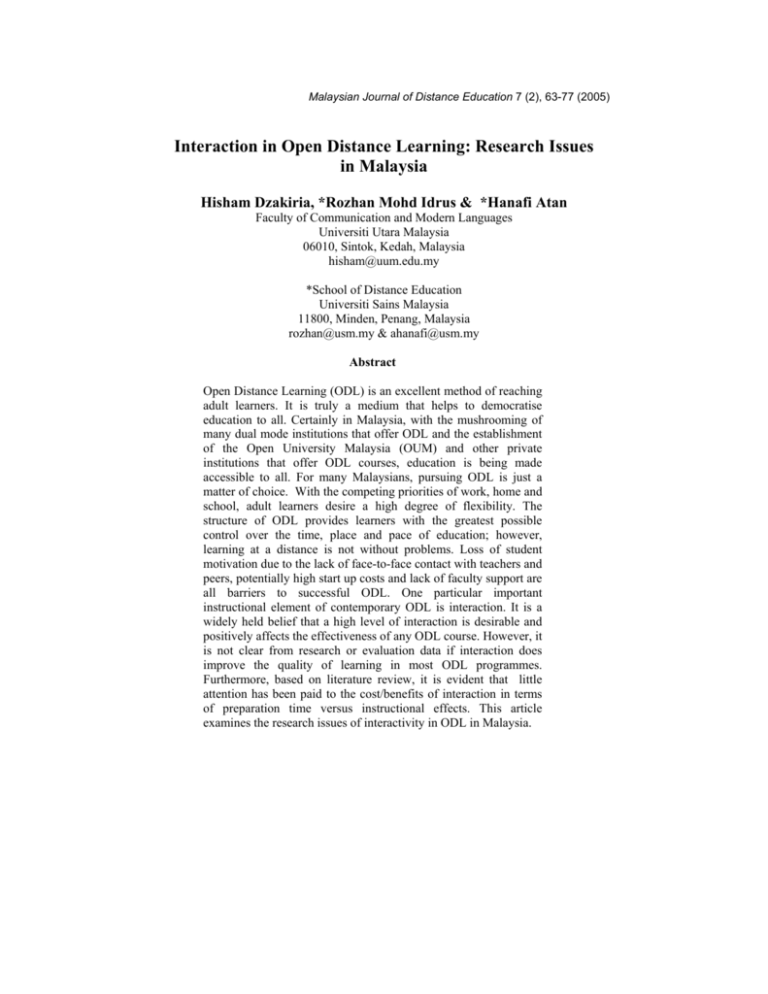
Malaysian Journal of Distance Education 7 (2), 63-77 (2005) Interaction in Open Distance Learning: Research Issues in Malaysia Hisham Dzakiria, *Rozhan Mohd Idrus & *Hanafi Atan Faculty of Communication and Modern Languages Universiti Utara Malaysia 06010, Sintok, Kedah, Malaysia hisham@uum.edu.my *School of Distance Education Universiti Sains Malaysia 11800, Minden, Penang, Malaysia rozhan@usm.my & ahanafi@usm.my Abstract Open Distance Learning (ODL) is an excellent method of reaching adult learners. It is truly a medium that helps to democratise education to all. Certainly in Malaysia, with the mushrooming of many dual mode institutions that offer ODL and the establishment of the Open University Malaysia (OUM) and other private institutions that offer ODL courses, education is being made accessible to all. For many Malaysians, pursuing ODL is just a matter of choice. With the competing priorities of work, home and school, adult learners desire a high degree of flexibility. The structure of ODL provides learners with the greatest possible control over the time, place and pace of education; however, learning at a distance is not without problems. Loss of student motivation due to the lack of face-to-face contact with teachers and peers, potentially high start up costs and lack of faculty support are all barriers to successful ODL. One particular important instructional element of contemporary ODL is interaction. It is a widely held belief that a high level of interaction is desirable and positively affects the effectiveness of any ODL course. However, it is not clear from research or evaluation data if interaction does improve the quality of learning in most ODL programmes. Furthermore, based on literature review, it is evident that little attention has been paid to the cost/benefits of interaction in terms of preparation time versus instructional effects. This article examines the research issues of interactivity in ODL in Malaysia. 64 Malaysian Journal of Distance Education 7 (2), 63-77 (2005) Abstrak Pendidikan Jarak Jauh dan Terbuka adalah kaedah yang terbaik untuk mencapai pelajar dewasa. Ianya merupakan satu ruang yang membantu untuk mendemokrasikan pendidikan kepada semua. Di Malaysia dengan banyaknya institusi yang menawarkan mod dualan yang menawarkan Pendidikan Jarak Jauh dan Terbuka dan penubuhan Universiti Terbuka Malaysia dan juga institusi swasta yang menawarkan kursus-kursus Pendidikan Jarak Jauh dan Terbuka, pendidikan boleh dicapai oleh semua. Untuk kebanyakan rakyat Malaysia, melanjutkan pelajaran melalui Pendidikan Jarak Jauh dan Terbuka merupakan satu pilihan. Dengan persaingan keutamaan di tempat kerja, rumah dan sekolah, pelajar dewasa memerlukan paras fleksibiliti yang tinggi. Struktur Pendidikan Jarak Jauh dan Terbuka memberikan pelajar dengan kawalan masa, tempat dan kadar pendidikan. Walau bagaimanapun pembelajaran secara jarak jauh bukannya tanpa masalah. Kehilangan motivasi pelajar disebabkan oleh kekurangan kontek bersemuka dengan guru dan rakan, kos awalan yang mungkin tinggi dan kekurangan sokongan fakulti merupakan halangan kepada kejayaan Pendidikan Jarak Jauh dan Terbuka. Salah satu unsur pengajaran yang penting dalam Pendidikan Jarak Jauh dan Terbuka ialah interaksi. Adalah dipercayai secara meluas bahawa paras interaksi yang tinggi amat diperlukan dan memberi kesan yang positif terhadap keberkesanan kursus Pendidikan Jarak Jauh dan Terbuka. Bagaimanapun ianya tidak jelas daripada kajian atau data penilaian sama ada interaksi mempertingkatkan kualiti pembelajaran dalam kebanyakan program Pendidikan Jarak Jauh dan Terbuka. Tambahan pula berasaskan kajian literatur adalah jelas bahawa perhatian yang sedikit telah diberikan kepada kos/kebaikan interaksi dari segi masa persediaan lawan kesan pengajaran. Kertas kerja ini mengkaji isu penyelidikan interaksi dalam Pendidikan Jarak Jauh dan Terbuka di Malaysia. Introduction The offering of ODL courses and programmes is consistent with the mission of the Malaysian Ministry of Higher Education, and is a critical endeavour for the survival of higher learning institutions (Dzakiria, 2004; Dzakiria & Idrus, 2003; Gibson, 1998). With the intent of making university courses and programmes more accessible to learners, several ODL and dual mode institutions in Malaysia are offering various courses and programmes. ODL delivery began in Malaysia in 1969 and today, it Interaction in Open Distance Learning 65 is only getting bigger, more popular and better. However, much can be done to make ODL a better learning option for prospective students. An important aspect of any ODL programme is continuous evaluation for ongoing improvement. Unfortunately, there has been a lack of systematic evaluation research focusing on interaction within ODL courses (Dzakiria & Idrus, 2003; Gibson, 1998). More research is needed on ODL and its technology use and particularly, on the students as they are the most important clientele to ODL. One pertinent issue that this article intended to focus on was the issue of interaction that has been highlighted in many forums and conferences as a central issue that needs greater attention. Much understanding is needed regarding the role and functionality of interaction and interactivity in ODL and how that may or may not affect the ODL completion success rate among the learners. A further distinction needs to be made between synchronous and asynchronous interaction (Murphy et al., 2001). In traditional classroom teaching, interaction is normally immediate and face-to-face. However, in ODL, interaction can be immediate with some media or delayed with others. This distinction between delayed or immediate interaction is very significant because it determines the logistics and “feel” of the distance learning experience. It creates a sense of belonging. In order to have immediate interaction, students must participate in learning at a fixed time whereas with delayed interaction, this participation is according to the student’s schedule. So, ODL programmes that involve delayed interaction provide students with more control and flexibility. On the other hand, classes that involve immediate interaction often have a sense of excitement and spontaneity that is not present with delayed interaction. That in some ways could dampen the learning process (Dzakiria, 2004). Finally, it is important to realise that ODL students could be similar and different in many ways. Due to their professional careers and backgrounds, they are more heterogeneous than homogeneous. The students appear to differ in their propensity for interaction depending upon their personality, age or cognitive/learning styles. Students who are more self-directed or autonomous may want/need less interaction than others. In general, professionals tend to prefer less interactivity, whereas younger students tend to want a high level of interaction. So the effectiveness of interaction may vary across individuals, groups and cultures. That makes 66 Malaysian Journal of Distance Education 7 (2), 63-77 (2005) the issue of interaction and interactivity an even more inviting issue to be discussed as ODL is truly as a system characterised by: • • • • • The separation of instructor and student during the instructional process. The influence of an educational organisation. Provision of student assessment. The use of educational media to deliver course contents. Two-way communication between the distance education teacher and the learner. In summary, the concept of interaction, as applied to ODL, is more complicated than its role in the traditional instructional theory or classroom teaching. In actuality, interaction in ODL needs to be differentiated according to: • • • • • Teacher with student interaction. Student with student interaction. Student with course contents. Immediate versus delayed interaction. Types of learners. Student Barriers to ODL Problems and barriers encountered by the students fall into several distinct categories: costs and motivators, feedback and teacher contact, student support and services, alienation and isolation, lack of experience and training. More than traditional students, distance learners are likely to have problems about learning (Donald, 1997; Dzakiria, 2004). As depicted in Dzakiria (2004) and Dzakiria & Rozhan (2003), students who come from the conventional form of education that practises teacher-centredness as opposed to student-centredness may find the transitional period of becoming an ODL student more challenging. Such problems are founded in personal and school related experiences and other contributing factors such as the financial costs of study, disruption of family life, perceived irrelevance of studies and lack of support from employers. These pressures Interaction in Open Distance Learning 67 often result in higher dropout rates than among traditional students (Dzakiria, 2004). A second area which is of interest to this article is the perceived lack of feedback or interaction with the distance teacher, respective tutor or lecturer. Due to the nature of ODL where there is lack of face-to-face contact with teachers, students may have trouble in learning and selfevaluation. It is important that students receive prompt feedback in any institutional setting, particularly in ODL where they are impaired by the lack of face-to-face contact with the teacher and other students. This is especially important for those students who do not live in big cities where connectivity, network system, and accessibility could be additional determining factors for a satisfactory of ODL educational experience. They may not have access to reliable telecommunications, computers and technology. The frustrations resulting from problems of interactivity between students and other ODL stakeholders are factors which distance education administrators should be continuously aware of. A third area of concern for distance students is the lack of support and services such as the availability of tutors, academic planners and schedulers and technical assistance. Students of all kinds want to be part of a larger community, and members of an ODL course. For many traditionally educated students, this is an important part of their social lives as iterated in the study done by Dzakiria (2004) that highlighted students’ feelings as “The teacher is always there, but really isn’t...”. This verbatim quotation is primarily evident of the student’s voice, pressing for the need for prompt, reliable, trusted services (Dzakiria, 2004) while doing a distance programme at Universiti Utara Malaysia. The isolation that results from the ODL process can complicate the learning process for adult students. Support for distance learners should not be overlooked when planning distance programmes. They need tutors and academic planners to help them complete courses on time and to act as a support system when stress becomes a problem. Dzakiria (2004) noted that student services are a significant part of the budgeted costs of any ODL programme. Dzakiria (2004), Dzakiria & Idris (2003 ), Murphy et al. (2001) and Tait, (2002) also believe that success in attracting, serving and retaining students will depend more on excellent student support services than on any technology issues. Technology costs and 68 Malaysian Journal of Distance Education 7 (2), 63-77 (2005) considerations can be a source of budgeting problems; however, student support for distance learners should take precedence. The “distance” aspect of distance learning takes away much of the social interactions that would be present in traditional learning environments. This problem must be mitigated by institutions providing a sense of personal involvement between the student and the institution. Both the distance teacher and learner need to be inducted into the ODL delivery system. The teachers must be trained and understand what and how to teach at a distance; the learners, on the other hand, must recognise the requirements and routine expected of distance learners. Distance education teachers need to interact continuously with students either electronically, by phone or face-to-face. Research has indicated that students believe that having a good distance education teacher is vitally important in helping them get the maximum benefit from a particular ODL course (Dzakiria, 2004). A fourth problem is prevalent with new distance education students. If distance learning institutions are serious about providing equity of educational opportunity to all, then careful consideration must be given to the special needs of students undertaking distance education for the first time. The design of study materials must take into account the inherent difficulties and challenges that students who enrol with little or no experience of distance studies. Such students are at risk of dropping out unless they develop study survival skills as rapidly as possible. They must know what ODL is all about, i.e., the learning and teaching process and other relevant facets of ODL. Making it compulsory for all new students to take an introduction to distance learning courses as practised by Universiti Sains Malaysia is commendable and should be followed by other dual mode and ODL institutions in Malaysia. Another problem encountered by students is the lack of student training, particularly with reference to technical issues. Many adult students are not well versed in the use of technology such as computers and the internet (Dzakiria & Idrus, 2003; Murphy et al., 2001). Using the electronic medium in distance learning can inadvertently exclude students who lack computer or writing skills. These skills are required if computer Interaction in Open Distance Learning 69 technology is used. Students will typically be offered volumes of onlinebased information. Using this information will be a problem for some nontechnical students. They must be taught how to manage, not only their study time, but the materials presented as well. If students who are undertaking distance learning courses require knowledge in computer usage, they must be taught, at a minimum, the fundamentals of operating the system of choice of the distance-taught course. If distance learning is to be successful, technical barriers must be made a non-issue. Analysing the above barriers, it is evident that two-thirds of the possible barriers to ODL surround the issue of interaction one way or the other. It is therefore particularly important for all ODL stakeholders to understand what interaction and interactivity entail and propose possible ways and avenues to improve interactivity in ODL. Interaction in ODL Interactivity has many different facets (Murphy et al., 2001). In the instructional theory, interaction provides the means for learners to receive feedback (Dempsey & Sales, 1994; Tait, 2000). In so far as feedback determines a successful learning progress, it can be argued that the more interaction provided, the better it would be for the learner, the learning and the teaching process. In the context of traditional classroom teaching, Flanders (1970), for example, made detailed studies of student-teacher interaction and concluded that increased interaction improved student achievement and attitudes towards learning. This is supported by Dzakiria (2004) and Dzakiria & Idrus (2003). The importance of interaction in ODL generally is acknowledged. This is evident in the literature (Billings et al., 2001; Boyle & Wambach, 2001; King & Doerfert, 2000; Meyen & Lian, 1997; Moore & Kearsley, 1996; Muirhead, 2001a, 2001b; Sherry, 1996; Wagner, 1994) and the concept of interaction in ODL has been the focus of much research (Billings et al., 2001; King & Doerfert, 2000; Muirhead, 2001a, 2001b). However, no consensual definition for interaction exists in the educational literature (Soo & Bonk, 1998, Dzakiria & Idrus, 2003; Dzakiria, 2004). The concept 70 Malaysian Journal of Distance Education 7 (2), 63-77 (2005) of interaction is a core element of the seven principles of good practice in education (Chickering & Gamson, 1987). These practices include the following: • • • • • • • Encouraging faculty/students contact. Developing reciprocity and cooperation. Engaging in active learning. Providing quick feedback. Emphasising the amount of time dedicated to a task. Communicating high expectations. Respecting diversity. Other authors have described some of the dimensions that comprise the concept of interaction, such as communication, collaboration and active learning (Kenny, 2002). The social process has been frequently highlighted in definitions (Beard & Harper, 2002; Crawford, 1999; Wagner, 1997). Additionally, interaction in web-based courses can occur synchronously or asynchronously (Smith & Dillon, 1999). Wagner (1997), on the other hand, made a distinction between interaction and interactivity. According to Wagner (1997), interactions “...occur when objects and events mutually influence one another. Interactivity . . . appears to emerge from descriptions of technology for establishing connections from point to point . . . in real time...” (p. 20). The disparity seems to be that interactivity involves the technology used in learning, while interactions describe behaviours of individuals and groups. Moore (1989) identified three types of interactions: student-content, student-teacher, and student-student. This fundamental distinction provides a basis for analysing the relative significance of different types of interaction in an open distance learning programme. Each type of interaction could have different effects on learners or the effectiveness of a course. In traditional classroom instruction, the focus has been on student-teacher interaction. On the other hand, in the development of self-study materials (especially computer-based or other forms of blended learning), the focus has been on student-content interaction. Until recent interest in Interaction in Open Distance Learning 71 collaborative/cooperative learning and the use of computer networks, little attention was devoted to student-student interaction and student-content interaction. Type of Interaction The nature of interaction also varies with the type of technology media or delivery system used: written (typed), audio (voice), video (face-to-face) or tactile (response units). The typical form of interaction for correspondence study was written assignments and feedback. This was certainly the medium used extensively in Malaysia back in the early 70s up till early the 1980s; this still represents the main form of communication between student and teacher/tutor in open university and independent study courses. Computer mediated communication also represents a form of written interaction. However, while the communication is in typed form, the interaction is much more complex than traditional writing since messages can have many characteristics (e.g., public versus private, forwarding, file attachments, etc.) and can also be searched/edited/filed. Furthermore, a different style of written communication is required for network communication compared to traditional correspondence (Angell & Heslop, 1994). Audio interaction is usually via a telephone or microphone. In the context of an audio-conference, the instructor must structure and manage the discourse very skillfully in order to produce effective classes since there is a high potential for confusion, chaos or boredom otherwise. On the other hand, there is typically little, if any, preparation for the audio portion of a teleconference since this is primarily used to answer questions from the audience. The sound quality of audio interaction is always a consideration in audio/teleconferences; poor quality may significantly reduce the effectiveness of a programme. Video interaction is a relatively new phenomenon for many dual mode institutions since two-way video-conferencing systems are just beginning to be commonly used in many ODL institutions. Clearly, the quality of the transmission affects how people interact via the video system. Presumably, other characteristics of the conferencing environment such as lighting, acoustics, room/seat layout and decor also affect interaction, but at the present time, their impact is unknown. 72 Malaysian Journal of Distance Education 7 (2), 63-77 (2005) While we know a little about each of these different forms of interaction in the context of their most common usage, many ODL administrators, policy makers, academics, in general, and ODL technicians are exploring and experimenting with mixing and combining different modes of interaction and producing a blended mode of learning. This is becoming an important issue in the age of multimedia systems which allow written, audio, video and tactile interaction. While many studies have investigated the effects of interactivity, few of these studies truly isolate the interactive component from other aspects of the ODL activity, nor do they distinguish the different facets of interaction discussed above. It is not surprising, therefore, that the results of these studies are inconsistent and the issue of interactivity remains unresolved. Pertinent Research Issues As the brief survey of the literature above illustrates, existing studies and literature do not really address fundamental issues relating to interactivity. This includes the following questions: • Is frequency of interaction in a course a meaningful measure of success or failure of ODL? • Is interaction more important for certain groups of learners than others (e.g., children versus adults)? • Is interaction more critical in certain kinds of learning than in others? • Does interaction affect ODL outcomes such as retention or transfer? • Does interaction increase ODL student comprehension/understanding? • Does interactivity always improve learner satisfaction? • What form of interaction is the most critical? • Should the pattern of interaction change over a course/programme? In order to examine these issues, we need studies that isolate specific dimensions of interaction. We also need descriptive studies that provide a clear picture of interactivity as it currently exists in ODL courses. A recent doctoral study completed by Dzakiria (2004) illustrates this latter category. Dzakiria found that interaction between student and student was much more common than interaction among students with their tutors or instructors, content or equipment. He also found that the amount of Interaction in Open Distance Learning 73 interaction increased as the complexity of learning increased, i.e., there was more interaction at an application level than in memory tasks. Building and Sustaining Interaction Even though there are many unanswered questions about interactivity, it is still possible to provide guidelines for improving the degree of interactivity in ODL. A variety of techniques for creating learner participation and generating discussions is recommended for teleconferences (Cyrs & Smith, 1990; Monson, 1978) as well as methods for increasing learner involvement in learning materials (e.g., advance organisers, self-assessment exercises). There are extensive guidelines available for interactive media (e.g., Lochte, 1993; Schwier & Misanchuk, 1993, Murphy et al., 2001; Simpson, 2002). Almost all such recommendations emphasise that interactivity must be planned or it is unlikely to occur (or be meaningful). The idea that interaction must be explicitly designed in ODL courses seems a difficult concept for many instructors to accept or understand. Furthermore, any effort to increase interactivity involves development and teaching efforts which must be accounted for. Even simple forms of interaction can take considerable time to prepare and carry out. When course enrolments are large, there are cost/benefit trade offs to be considered in providing interactivity (Dillon et al., 1991). Unless there are clear-cut benefits to adding interaction to a course, designers and instructors are not likely to invest the time to do so. Finally, we need to consider that the perception of interactivity may be as important as actual interaction. Fulford & Zhang (1993) examined learner perceptions in a course delivered by instructional television. They found that the critical predictor of student satisfaction in the course was not the extent of personal interaction, but the perception of overall interaction. In other words, if students perceived that there had been a high level of student interaction in the course they were satisfied, regardless of how much interaction they had personally. This result suggests that the potential for interaction is an important design factor in open distance learning courses, even if most students do not take advantage of this potential. Responsibility for creating interactivity in ODL programmes rests with the course instructors. Distance education teachers must build interactive 74 Malaysian Journal of Distance Education 7 (2), 63-77 (2005) sequences into their classes either in terms of simple question and answer sessions or more elaborate problem-solving or game activities. Similarly, distance instructors anywhere in the world must provide assignments and group activities that entail interaction. While the preparation time is not appreciable, the time required to conduct interactive segments and provide feedback can be significant. This is particularly a problem because each message must be read and replied to. For example, if a class of 30 students completes an assignment and it takes the instructor 20 minutes to read and reply to each one, a total of 10 hours is required to provide feedback to all students. If the class enrolment is large or there are many interactive activities, this can present a tremendous load on the instructor. We do not have any data that tell us how the two kinds of interaction affect student achievement. We do know from evaluation studies, however, that both kinds of interaction are valued by students and contribute to their satisfaction (or dissatisfaction) with the programme. Some students report that they feel less involved in the class than other students. Other students say that having the opportunity to interact with the instructors and their classmates is one of the best features of ODL . On the other hand, students who do not receive timely feedback on their online assignments from the instructors become very frustrated (Dzakiria, 2004). So we feel that when conducted properly by distance teachers, interactivity increases the motivation of students to complete ODL courses. Conclusion It is difficult to make a cost/benefits evaluation of interactivity in any ODL programme. In the case of many ODL institutions and programmes, the direct costs of providing interaction are relatively modest. The benefits are increased student involvement and satisfaction with the ODL courses. However, there are many indirect costs associated with providing these interactive capabilities, including the needed equipment and the expenses associated with the modern state-of-the-art technology in the transmission or operation of ODL courses, as well as the time required by instructors for the preparation and completion of these courses. If only the direct costs are considered, the benefits would seem to easily outweigh the costs; however, if all of the items related to the provision of interactivity are taken into account, it may not be worthwhile. In the absence of evidence Interaction in Open Distance Learning 75 that interactivity has a significant effect on student achievement, it is not possible to make a better assessment. To make this determination, we need to conduct studies that measure the impact of different types of interactivity on learning outcomes (i.e., comprehension, retention, transfer, etc.). The costs/benefits of interactivity are likely to vary with different media, teaching strategies, types of learning and groups of learners. Nevertheless, the possible benefits in terms of impact on learning are probably quite limited. Moreover, creating interaction in a teleconference among individuals located at different sites could be quite expensive when preparation time and satellite costs are taken into account. Some forms of interaction, such as simulations, games or case studies, are more complicated to create but may have greater impact on learning. Finally, some groups of learners (e.g., young children, teenagers, senior executives, engineers, foreign students) may be more or less inclined to interact, and may derive varying degrees of benefit from such interaction. Therefore, the value of interaction needs to assessed on a case by case basis for each ODL programme. In conclusion, ODL is an excellent method of reaching adult learners in Malaysia and elsewhere. Because of the competing priorities of work, home and school, adult learners desire a high degree of flexibility. The structure of distance learning gives adults the greatest possible control over the time, place and pace of education; however, as this article has shown, it is not without problems. Loss of student motivation due to the lack of face-to-face contact with teachers and peers, potentially prohibitive startup costs and lack of faculty support are all barriers to successful distance learning. This article reviewed one particularly important variable that determines a favourable, enjoyable and desirable ODL learning experience. References Angell, D. & Heslop, B. (1994). The Elements of E-mail Style. Reading, MA: AddisonWesley. Beard, L.A. & Harper, C. (2002). Student Perceptions of Online Versus on Campus Instruction. Education, 122, pp. 658-663. Billings, D.M., Connors, H.R. & Skiba, D.J. (2001). Benchmarking best practices in Web-based nursing courses. Advances in Nursing Science, 23, pp. 41-52. 76 Malaysian Journal of Distance Education 7 (2), 63-77 (2005) Boyle, D.K. & Wambach, K.A. (2001). Interaction in graduate nursing Web-based instruction. Journal of Professional Nursing, 17, pp. 128-134. Chickering, A.W. & Gamson, Z.F. (1987). Seven Principles for Good Practice in Undergraduate Education. AAHE Bulletin, 39(7), pp. 3-6. Crawford, M.W. (1999). Students’ Perceptions of the Interpersonal Communication Courses Offered Through Open Distance Learning (Doctoral dissertation, Ohio University, 1999). UMI Dissertation Services, (UMI No. 9929303). Cyrs, T.E. & Smith, F.A. (1990). Teleclass Teaching: A Resource Guide (2nd Ed). Las Cruces, NM: New Mexico State University. Dempsey, J.V. & Sales, G.C. (1994). Interactive Instruction and Feedback. Englewood Cliffs, NJ: Educational Technology Publications. Dillon, C., Gibson, C. & Confessore, S. (1991). The Economics of Interaction in Technology-based Open Distance Learning. Proceedings of the Seventh Annual Conference on Distance Teaching and Learning. Madison, WI: University of Wisconsin. Donald, J. (1997). Improving the Learning Support for Learning. San Francisco: JosseyBass Publishers. Dzakiria, H. & Idrus, R.M. (2003). Teacher-Learner Interactions in Distance Education: A Case of Two Malaysian Universities, Turkey On-line Journal of Distance Education (TOJDE), Volume 4(30). ISSN 1302-6488, http://tojde.anadolu.edu.tr/tojde11/articles/idrus.htm. Dzakiria, H. (2004). The Teacher is Always There, but isn’t...Distance Learners’ Experiences & Perspectives on Distance Learning at Universiti Utara Malaysia. University of East Anglia, UK. Unpublished thesis. Flanders, N.A. (1970). Analyzing Teacher Behavior. Reading, MA: Addison-Wesley. Fulford, C.P. & Zhang, S. (1993). Perceptions of interaction: The critical predictor in open distance learning. Amer. J. Distance Education, 7(3), pp. 8-21. Gibson, C.C. (1998). The Distance Learner in Context. In C. Gibson (Ed.). Distance Learners in Higher Education: Institutional Responses for Quality Outcomes. Madison, Wisconsin: Atwood Publishing. Kenny, A. (2002). Online learning: Enhancing nurse education? Journal of Advanced Nursing, 38, pp. 127-135. King, J.C. & Doerfert, D.L. (2000). Interaction in the Open Distance Learning Setting. Retrieved 5 January 2004, from the World Wide Web: http://www.ssu.missouri.edu/ssu/aged/naerm/s-e-4.htm Lochte, R.H. (1993). Interactive Television & Instruction. Englewood Cliffs, NJ: Educational Technology Publications. Meyen, E. & Lian, C.H.T. (1997). Developing online instruction: One model. Focus on Autism and Other Developmental Disabilities, 12, pp. 159-165. Monson, M.K. (1978). Bridging the Distance. Madison, WI: University of WisconsinExtension. Moore, M.G. (1989). Three types of interaction. The American Journal of Open Distance Learning, 3(2), pp. 1-6. Moore, M.G. & Kearsley, G. (1996). Open Distance Learning: A Systems View. Belmont: Wadsworth Publishing Company. Interaction in Open Distance Learning 77 Muirhead, B. (2001a). Enhancing Social Interaction in Computer-Mediated Open Distance learning. USDLA Journal, 15(4). Retrieved 4 January 2004, from the World Wide Web: http://www.usdla.org/html/journal/APR01_Issue/article02.html Muirhead, B. (2001b). Interactivity research studies. Educational Technology & Society, 4(3). Retrieved 4 January 2004, from the World Wide Web: http://ifets.ieee.org/periodical/vol_3_2001/muirhead.html Murphy, D., Walker, R. & Webb, G. (2001). Online Learning and Teaching With Technology: Case Studies, Experience and Practice. London: Kogan Page Limited. Rumble, G. (2000). Student Support in Distance Education in the 21st century: Learning from service management, Distance Education, 21(2), pp. 216-235. Schwier, R.A. & Misanchuk, E. (1993). Interactive Multimedia Instruction. Englewood Cliffs, NJ: Educational Technology Publications. Sherry, L. (1996). Issues in distance learning. International Journal of Educational Telecommunications, 1, pp. 337-365. Retrieved January 5, 2004 from the World Wide Web: http://carbon.cudenver.edu/~lsherry/pubs/issues.html Simpson, O. (2002). Supporting Students in Online, Open and Distance Learning (2nd edition), London: Kogan Page. Smith, P.L. & Dillon, C.L. (1999). Comparing distance learning and classroom learning: Conceptual considerations. American Journal of Open Distance Learning, 13(2), pp. 6-23. Soo, K. & Bonk, C.J. (1998). Interaction: What does it mean in online open distance learning? Paper presented at the ED-MEDIA/ED-TELECOM 98 World Conference on Educational Multimedia and Hypermedia & World Conference on Educational Telecommunications (10th), Freiburg, Germany. pp. 20-25 June. (ERIC Document Reproduction Service No. ED 428724). Tait, A. (2000). Planning student support for open and distance teaching. Open Learning, 15(3), pp. 287-299. Wagner, E.D. (1994). In support of a functional definition of interaction. The American Journal of Open Distance Learning, 8(2), pp. 6-29. Wagner, E.D. (1997). Interactivity: From agents to outcomes. In T.E. Cyrs (Ed.), Teaching and Learning at a Distance: What It Takes to Effectively Design, Deliver, and Evaluate Programs. San Francisco: Jossey-Bass Publishers.
